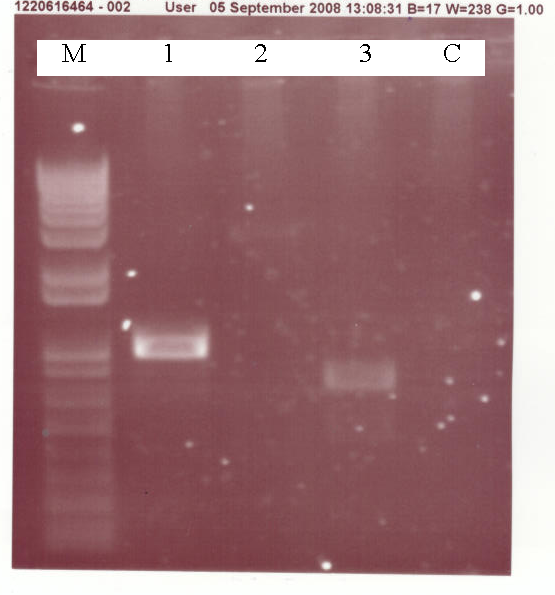4 September 2008
Wetlab
Cloning
- Pfu PCR reactions for LacI gene, Aad9 gene and AmyE 3' Integration Sequence were set up using the standard conditions and reagents [1]; LacI and AmyE 3' at 52°C for the first 10 cycles and 65°C for the last 20, Aad9 at 52°C then 60°C. 5μl of each PCR reaction run on a gel. Results are shown below.
- CAT biobrick digested with EcoRI and SpeI ready for assembly with the terminator
- Termiantor biobrick cut with EcoRI and XbaI ready for assembly with CAT
- GFP-Termiantor biobrick cut again with XbaI and SpeI to produce biobrick vectors for our PCR clones
- GFP-Termiantor biobrick cut again with EcoRI and SpeI to produce biobrick vectors for our GeneArt produced clones
Results
 A 1% Agarose gel showing the results of various PCR reactions. Each lane is loaded with 5ul of PCR reaction and 1ul of 6x sample buffer. M = Marker, lane 1 is the AmyE 3' Integration sequence, lane 2 the LacI and lane 3 the Aad9 PCR reaction As can be seen, both the AmyE 3' integration sequence and the Aad9 (spectinomycin resistance) gene amplified properly. However, LacI did not and therefore, needs to be repeated.
Preparation of Electrocompetent E. coli Cells
We have prepared 42 aliquots of electrocompetent XL1 Blue E. coli cells using the relevant protocol listed on our Protocols Page. The protocol was updated to include a higher innoculation value from the overnight culture.
Dry Lab
Motility
- Tested Volocity software on 64-Bit analysis computer in SAF (FILM facility). Visually, volocity tracks cells very well, including synthetic data with a single motile ellipse without any change in shape. However, the software is unable to continuously track synthetic data of multiple ellipses with changing shape. It loses track of the cells after a few frames. When tested on real data, it tracks cells which run for fairly long, but it does not track tumbling cells. Most tracks do not last over 30 frames, which is considerable little for any form of good data to be extracted.
- Hence we are still pursuing manual tracking, but if time permits, we will attempt to use other forms of filtering to achieve the best form of tracking for Volocity.
- Error bars were plotted for Volocity software and uploaded onto the OWW Wiki.
|
 "
"

